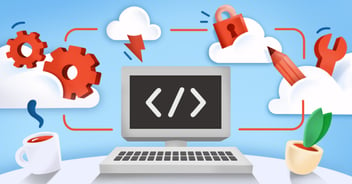Shopify is a great tool to set up an e-commerce website for small and medium sized businesses. It offers both online and offline sale platforms with their Shopify POS system, has a great backend that shows you how your products are performing, and where your customers are coming from. Shopify even offers a host of free tools and features, as well as a responsive support team and free ecommerce classes.
So what more can Shopify Plus offer? Let’s look at the key differences between Shopify vs Shopify Plus.
Shopify Plus Comes With Dedicated Support
One of the main differences between Shopify vs Shopify Plus is the dedicated and personalized support offered with the service. Shopify Plus assigns a dedicated solutions engineer to your business, who acts as a development concierge, troubleshooting any technical components that need to be integrated. You will also be assigned a launch engineer, who assists you with your migration to Shopify Plus and helps you understand the new tools that can help your business grow. All of these services come at a more significant cost investment, however, the higher your sales volume, the more value these services will have.
Shopify vs Shopify Plus: Get Unlimited Staff Accounts With Shopify Plus
With Shopify you are limited to a certain number of accounts. Each account in Shopify is capped at 1, 2, 5, or 15 staff accounts depending on the plan tier that you choose. This restricts businesses from allocating their admin duties to as many employees and team members as they please. The beauty of Shopify vs Shopify Plus is that don’t have to worry about being selective with your staff, as you have the allowance to create unlimited accounts. Simply put, if your team and business ventures are expected to grow in size, your account can more easily grow with you to meet new demands.
Shopify Plus Has an Overview Dashboard
Key metrics and analytics are essential tools for tracking any eCommerce store’s successes and shortcomings. Comparing Shopify vs Shopify Plus both contain excellent analytics tools, but Shopify Plus dives even deeper into your business’s performance and activity with the help of an overview dashboard feature. This makes it simpler than ever to differentiate your metrics across multiple Shopify stores and gain a solid understanding of your overall sales, order value, visitor sessions, and other critical statistics.
Shopify Plus Gives You Have Access to Complete Customization
In order to build authentic relationships with your consumers, a customized Shopify store is the way to go. This key difference between Shopify vs Shopify Plus is that you will notice that Shopify Plys gives you the opportunity to showcase your unique style, branded elements, and tailor an eCommerce experience to fit your target consumer’s needs. If complete creative control is what you seek, then Shopify Plus is an optimal platform for you.
While both plans contain customization capabilities, Shopify Plus has more to offer. There are 100 themes to choose from, customization at the coding level with Liquid (Shopify’s theme language), and the even ability to customize the checkout experience. These work together to create the best customer service possible.
Shopify Plus Offers Additional API Integrations and Exclusive Apps
One big difference between Shopify vs Shopify Plus is that Shopify Plus has a plethora of integrations and applications available. In general, these features ensure that your store is running efficiently for both your front-facing consumers and employees on the backend. Some of these features include:
-
Third-Party App Integrations: GiftCard and Multipass improve the functionality of your site immensely. GiftCard allows you to create and manage gift cards while Multipass streamlines the process of consumers signing into Shopify with the same email from your website.
-
Private Applications: With Shopify Plus, you can create private apps with partners to add helpful features to your site, created entirely for your unique page (not for any other storefront like a public app.)
Shopify Plus Has a Wholesale Channel
A defining feature that sets Shopify Plus apart is its ability to add a wholesale channel. Possessing a wholesale channel with Shopify vs Shopify Plus gives you the chance to host exclusive wholesale products and shift your pricing to be solely catered to your B2B audiences. If your business currently has both B2B and B2C business strategies or is planning to expand into both of these realms, Shopify Plus lets you grow into these endeavors. It organizes and separates the logistics of your storefronts and even warrants a different set of passwords for each.
Shopify vs Shopify Plus: Shopify Plus Will Give Developers Access to Exclusive Resources and Groups
The price tag of Shopify Plus undoubtedly brings you more built-in support than a traditional Shopify account. Part of this support is greater accessibility to resources and groups. These resources are driven to provide you assistance in improving and expanding your headless commerce storefront.
Shopify Plus has assembled a directory of partners with services that share their expertise on all facets of owning an online store. This information ranges from UX to SEO to marketing to everything in-between.
How Much Does Shopify Plus Cost?
It’s no surprise: one of the first questions everyone is going to ask is “How much does Shopify Plus cost?” It may be quite a ‘sticker shock’ to some businesses. That’s because Shopify Plus is designed for large businesses and corporations, rather than Shopify’s core users that own small to medium sized businesses. Shopify Plus will set you back $2,000 a month at minimum, or 0.25% of your sales volume per month, capped at $40,000 (whichever is greater). While a substantially sized company may not find those numbers shocking, a small business will probably not generate enough sales to make the extra features of Shopify Plus worth the cost.
Shopify VS Shopify Plus: Leverage The Power of Shopify Plus
All in all, Shopify Plus has a robust set of features that enable businesses to take their eCommerce shops to the next level of professionalism. Those with larger budgets, revenue, and employee bandwidth would benefit the most from this upgrade, while smaller businesses with lower budgets and experience are best left with the traditional plan.
Whatever store you decide upon, it is important to remember that each platform has a number of benefits and challenges that impact every business differently, so always choose with your unique priorities and goals in mind.



